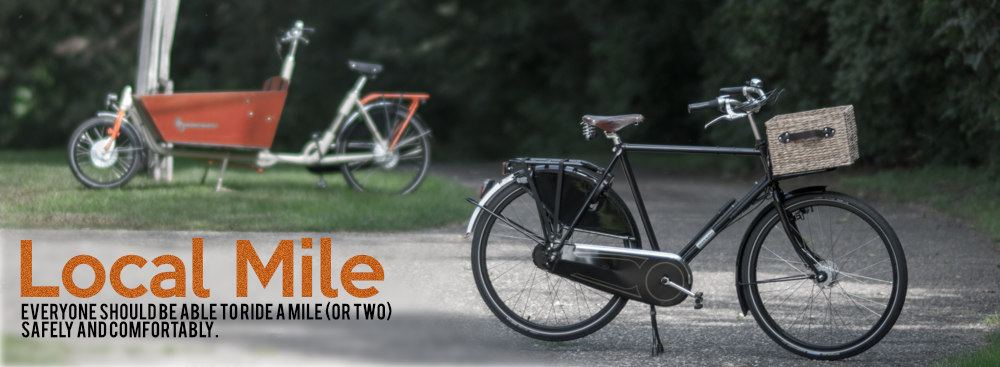Barrels are quite popular in the U.S. and somewhat in other english speaking countries. They seem like a great idea, have a low initial cost, are fast and easy to assemble and they’re cute.
Despite marketing claims however, they have numerous drawbacks that make them a not so good choice and are, according to some Finns, not really a sauna. Numerous people in Finland have mentioned to me that Finns are quite thrifty and would love the savings that a barrel appears to offer but the sauna experience and longevity aren’t good and the perceived costs misleading. Which is why you don’t see barrels in Finland or other sauna knowledgable countries.
It appears that barrel saunas were actually invented in Finland (in one story by Esko Niinimäki though as Lassi points out, there were others prior) but never became very popular due to their not providing a good sauna experience unless very very large.
Hopefully this will provide people with the same knowledge that Finns and others have about barrels so that they can make the same informed choice. This is an addendum to Trumpkin’s Notes On Building A Sauna that you can or should read (particularly the section ‘How Saunas Work and Sauna Heat Zones’) for further detail on why bench and ceiling heights, ventilation and other elements are so critical and why Finn’s are so adamant about the foot bench being above the stones. Other sauna resources are in the menu above.
If you have a barrel and you enjoy it that’s great. Perhaps 5-10% of people who buy them do enjoy them for many years. If you have a barrel and you’d like to improve it, there are some ideas near the end.
Summary of issues:
- Too Little Volume Per Bather – For healthy air to breathe a sauna should have a minimum of 3 m³ (100 cubic feet) per person though ideally 4-5m³ (assuming proper ventilation), barrels often have only about 1m³ per peron, 1/3 the required amount.
- Bacteria, Mold & Other Fungi – Due to being so low, the foot bench (floor in small barrels) does not maintain the 65°c (150°f) temps necessary to kill mold and bacteria.
- Too Low Of Benches – Too great of temperature and steam stratification resulting in cold feet, cold legs and not so hot bodies. Bathers should have a head to toe temperature difference of no greater than 36°f and never more than 48°f – barrels range from 60-120°f. We should be evenly enveloped in steam but steam does not descend below about 8″ above the top of the stones.
- No Heat Cavity Above The Door – Every time the door opens a bit of heat escapes to be replaced by cold air. Besides being uncomfortable and increasing stratification, this gets expensive and is one reason why in reality barrels can cost 2-5x as much to heat vs proper cabin saunas.
- Direct Radiant Heat From The Heater – Undesirable in a sauna. Bathers should feel no noticeable radiant from the heater.
- No Vestibule/Changing For An Air Lock.
- Odors – Primarily from bacteria in benches that’s not killed by heat but also mold and poor ventilation.
- Poor Convective Loop – Reduces or eliminates the evaporative cooling of bathers skin.
- Leaks and Water Stains
- Can’t Sit Up Straight / Lean Back
- Fire Risk – The small size, low ceiling and shape may be more likely to catch fire than a cabin.
- Low Cost Is Misleading – Higher operating costs (≈$2-5 / hr vs ≈ $1/hr) are the big issue but costs of add-ons and fixing problems and that they often don’t last long can make barrels much more expensive.
- Short Lifespan – Barrels often become unusable after 3-5 years due to expansion/contraction, stays and end panels no longer sealing well enough, mold and rot.
- No Insulation – Greater energy loss, higher electrical costs and less bather comfort.
- Disuse – While a proper sauna is typically enjoyed routinely for life, barrel owners often get tired of them after the novelty wears off (2-4 years) and get left to rot.
Better Than Nothing? – For a tiny few maybe. Long term though, not for many or most people – who will use it a fair amount the first year when it’s a new and novel experience, less the second and hardly at all after the fourth. It is perhaps better than nothing for hardcore enthusiasts who truly have no better alternative and are willing to put up with the drawbacks.
Worse, people think that they’ve experienced sauna when they’ve not. They buy a barrel, get tired of the poor experience after 2 – 4 years, and think that they just don’t like saunas. But they’ve not experienced a sauna. Saying that a barrel gives people a taste of sauna is like saying that vinegar gives people a taste of a good wine.
A Better Alternative? – This 6 x 7 x 8.5’ sauna from Cedarbrook would be about $8600 with the 8.5’ ceiling and will provide a much better sauna experience than a barrel (and with the proper ceiling and bench heights would be better than probably 99% of all saunas that currently exist in North America). Depending on your environment and how much you use it this cabin sauna will likely use about $600-$1000 per year less electricity than a barrel so after ≈1-3 years the additional cost over a barrel will be covered (E.G., you’d have spent the same for purchase plus operating costs). Don’t forget to add the costs of a roof for the barrel.
Outside of North America barrels are purchased primarily to get around building codes that won’t allow a cabin (that would be considered a permanent structure). They are kind of the sauna of last resort. Or… scraping the bottom of the barrel 🙂
“If barrels were any good you’d see more of them in Finland”
– John S, A Finn
Being the frugal lot that they are, barrels were somewhat popular in Sweden for a very brief period in the early 2000’s resulting in Finns referring to barrels with the derogatory, though light-hearted, term ‘Svensson Sauna’.
If you are considering buying a barrel. I’d strongly recommend not to do so unless you are buying a larger 10’ diameter barrel or a small barrel is truly your only option due to building codes or other constraints. If so, find one with a higher bench located on the end similar to the one pictured below.
Barrels under about 9-10’ diameter are simply not good for sauna. Some elements of sauna like overall temperature, humidity level, wood vs electric heat and what wood to use on walls are personal preference. Nobody however likes or wants cold feet, getting blasted with cold air or having the heat sucked out every time the door is opened, bad stale air or breathing mold spores …. Those aren’t preferences but undesirables. And they come with every small barrel.
Post-Purchase Rationalization – There are a lot of people who’ll say that they bought such and such kit or barrel and love it. Often this is indeed true. Two things to consider here. In the vast majority of cases these are comments from people who have little or no experience with real saunas – they’ve not been to Finland and don’t know what a sauna is supposed to be so have no idea if their barrel is good or bad. This isn’t their fault. If the only coffee you’ve ever been exposed to is freeze dried instant then how can you know how much better good fresh coffee is. As well, these comments are often made while the sauna is new and novel, before it’s fallen to disuse because it’s really not that great of an experience.
And then sometimes people are not being so truthful. They spent, or wasted, a bunch of money and want to rationalize their purchase.
As several Finn’s have told me – There are many very good reasons you don’t see barrels in Finland.
In tracking real estate listings to get an idea of how many homes have a sauna and what kind and quality, there’s a surprising lack of barrels given how many are sold in the U.S. every year. About 13-22% of saunas should be barrels based on sales numbers. Reality is 0.3% or about 1 in every 320 saunas. Where’d they all go?
Real estate agents have commented that most barrels they’ve seen are rotted or in otherwise unusable condition so they recommend that they be hauled off before the house is put up for sale.
Moving A Used Barrel
I’ve never heard of anyone doing this successfully. First is that quite often a number of parts are found to be rotted during disassembly and need to be replaced. Then the moved or reassembled barrel does not seal back up well (even if nothing was rotted) so it has numerous more air and water leaks than prior to moving. Even if it can be made useable it is more susceptible to rot than it was before being moved.
Most used barrels have considerable odor from months or years of embedded bacteria and mold growth. The only way to remove this from the wood is to heat to wood to 65°c for 20-30 minutes.
The characteristics of a good sauna are:
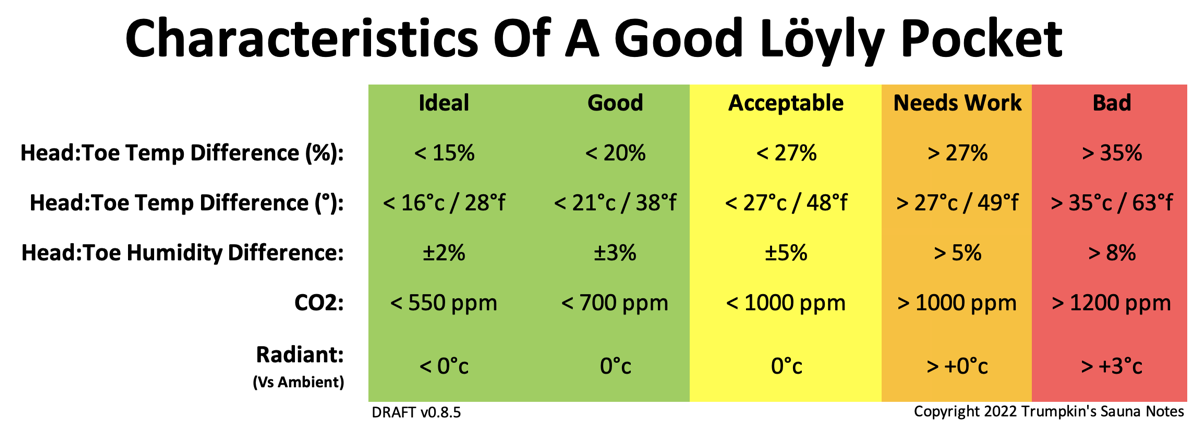
I’d like to propose a bit of Sauna Truth In Advertising. Every manufacturer of any kind of pre-made kit or barrel sauna and every sauna builder should, if they believe in their product, publish the following for each product:
- Line chart of actual measured temperatures over a period of time at the floor, foot bench, sitting bench and 1m above the sitting bench.
- Line chart of CO2 levels.
- Radiant Temperature measurements for each seat.
- Line chart of relative humidity over 30 minutes.
- Photo showing the advertised number of people sitting in the unit.
This should provide consumers with some accurate objective information upon which to base decisions. More details on the Test & Measurement page in the menu above.
Building Code/Regulations – Barrels can sometimes be placed nearer to property lines than a stick built cabin style sauna which is a significant advantage in smaller yards. A cabin might require a permit while a barrel not and a barrel might be considered temporary rather than a permanent structure. This is perhaps the one logical reason for choosing a barrel over a cabin.
While small barrels are rather rare outside of North America, when they do build them they usually have a seating arrangement that gets bather’s as high in the space as possible. Still not as good as a proper cabin but much better than the typical low bench arrangements sold in the U.S.
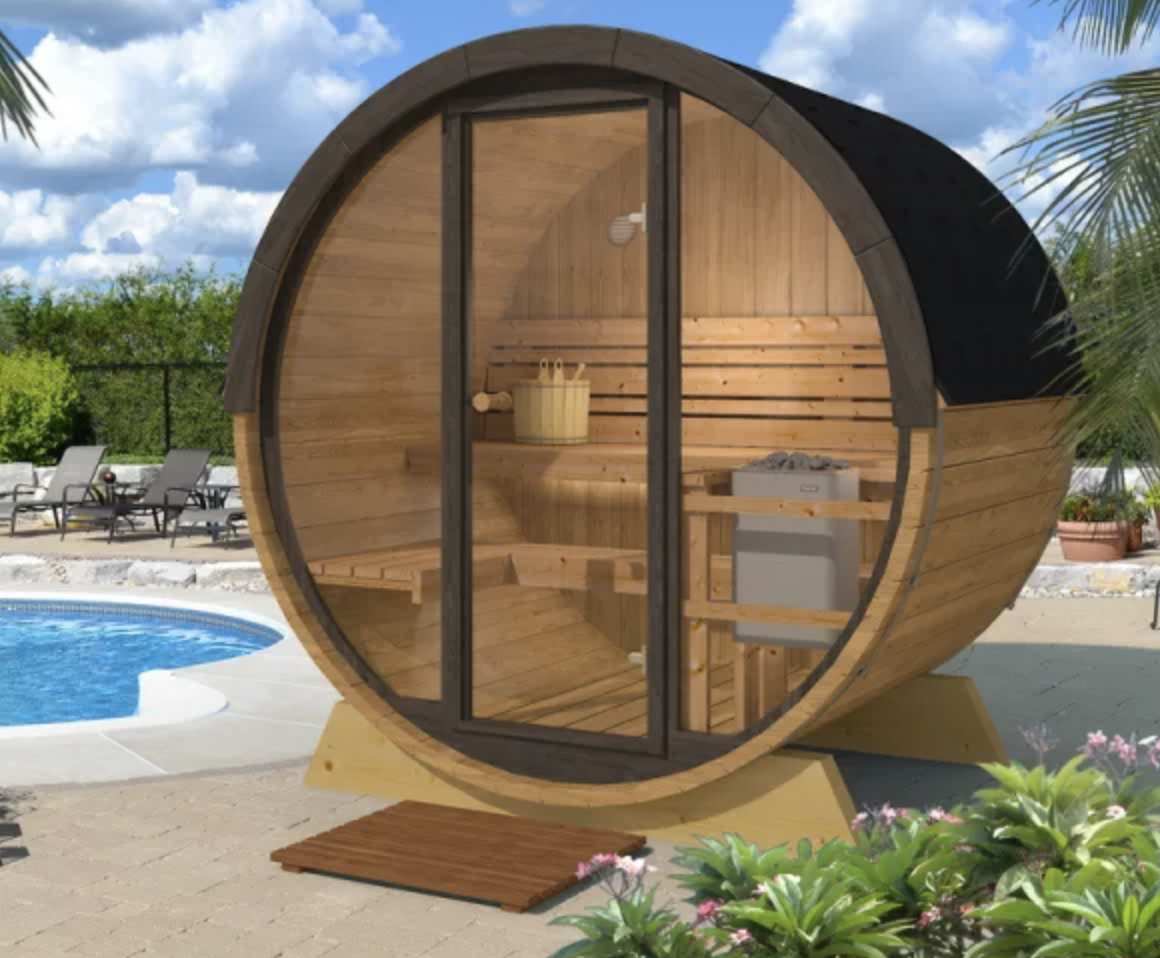
A better alternative might be to build a cabin sauna on a trailer. An ice house trailer with raisable wheels may be a good option for this. Even a small cabin will provide a much better sauna experience than a barrel.
Perceived Lower Cost – The initial purchase and shipping cost is often lower than alternatives. Long term and operating costs are quite different however.
Fast Delivery – If you don’t want to wait a few weeks or months then a barrel is often the better or only option.
Easy and Fast Assembly – Most people can assemble it and have it running in one to three days.
Attractiveness – They’re cute.
Size – People say size. However, a cabin sauna on the same footprint taking up the same space will provide a healthier and better experience.
Perhaps the big one though is that we don’t know what we don’t know. We lack a good reference for what good sauna is. We think the cold feet and poor air quality in a barrel is normal. It’s not. We compare our barrel to a typical American sauna with no löyly and cold feet from too low of benches and poor ventilation and our barrel isn’t much worse so it must be a pretty good sauna.
People who have barrels and never experience anything better are often quite happy with their barrel. Especially if they live in a more temperate climate. And that’s rather good. And some people are just not very picky so a poor barrel is just as good for them as the best sauna in Finland. And that’s OK too. I’ve a friend who thinks freeze dried coffee is just as good as fresh ground drip and I’m happy for him. However, a barrel owner, once they experience a real Finnish sauna, realize what they’ve been missing, what real sauna is like, quickly become dissatisfied and want a real sauna.

Barrels are a true bigger is better thing. A larger barrel, 3m or 10’ in diameter, that has the foot benches above the stones, a heat cavity above the door, bathers heads not too far below the ceiling, good ventilation and a vestibule can work well but smaller barrels, like typical in North America, are not built like this.
Barrels under 8-10’ in diameter do not and cannot provide a good sauna experience. Air quality is quite poor and bathers often do not experience sauna temps (consistent 80-105°c at head and shoulders, no more than 20°c cooler at feet). Uncomfortably cold feet and chilly backs are difficult or impossible to avoid. Here bigger is better. 6’ is, compared to a proper sauna, rather awful, 7’ is somewhat better, 8’ done well can likely provide at least a minimally acceptable sauna, 9’ is doable and can almost provide an experience similar to a proper cabin sauna. Sounds dramatic and harsh but is the unfortunate reality.
According to marketing materials the shape is supposed to make the heat roll evenly around bathers, but physics, stratification of heat and steam, doesn’t actually work like that. I’ve a growing collection of photos of people’s attempts at alleviating some of the problems of barrels with boxes on top benches, intricate fan arrangements, tents as vestibules and other stuff.
Some of the problems include;
Poor Ventilation – Natural convection often doesn’t work well in any electric heated sauna but is worse in barrels due to the lack of height and other characteristics necessary for it to effectively remove CO2, VOC’s and pathogens and provide oxygen.
Too Little Volume Per Bather – The recommended interior volume for a sauna to have healthy air is a MINIMUM of 3 m³ (105 cubic feet) per person and ideally more. This is assuming proper working ventilation.
The volume of space per person in a barrel is typically much less than this which when the door is closed can result in CO2 and pathogen levels increasing quickly and to quite high and unhealthy levels*. People in a little barrel are quite literally breathing each others exhaled breath. High CO2 levels result in people feeling that they need to exit the sauna to get a breath (rather than from heat & löyly) or are feeling light-headed or dizzy. High ventilation rates (assuming good dispersion/mixing which is quite a bit more difficult in a smaller space) can help with this but in such a small space, even with an adequate heater, often results in cold airflow streams on bathers, particularly around their feet. Each time the door opens helps to alleviate the high CO2 and pathogen levels a little but also brings in colder air, allows heat to escape and then takes a long time to get back to temp (as long as there is any heat in the sauna then there is excess CO2 and pathogens).
One popular 4 person barrel that is 6’ (71”) in diameter by 5.3’ (64”) in length has 148 cubic feet (37 cubic feet per person) which is about a quarter of the 530 cubic feet recommended volume (and less than half of the 315 cubic feet that is considered the absolute minimum for four people). CO2 levels will increase two to four times as fast in a barrel as a proper sauna.
Bacteria, Mold & Other Fungi – Due to being so low, the foot bench (floor in barrel saunas) rarely or never maintains the 65°c / 150°f temps necessary to kill most mold and bacteria so growth of these, particularly bacteria, is a common problem in barrels. Once present it is largely impossible to get rid of. Chemicals cannot penetrate to the roots so kill only the heads which grow back. Some people claim to have had moderate success with regular cleanings with vinegar. Some molds are only an aesthetic problem and not a health concern while others as well as bacteria can be a health problem.
Too Low Of Benches = Cold Feet – The primary problem is cold feet but often cold legs and not so hot bodies as well. Good sauna builders will always try to avoid having the foot bench, and so any part of bathers bodies, in the lower 1/3 of the space (the Cold Zone) since this area in any sauna is always rather cool, stratified and rarely experiences the steam. The good heat, steam and löyly is above bathers heads in barrels and bathers are down in the cold zone. Here’s how various ceiling heights compare:
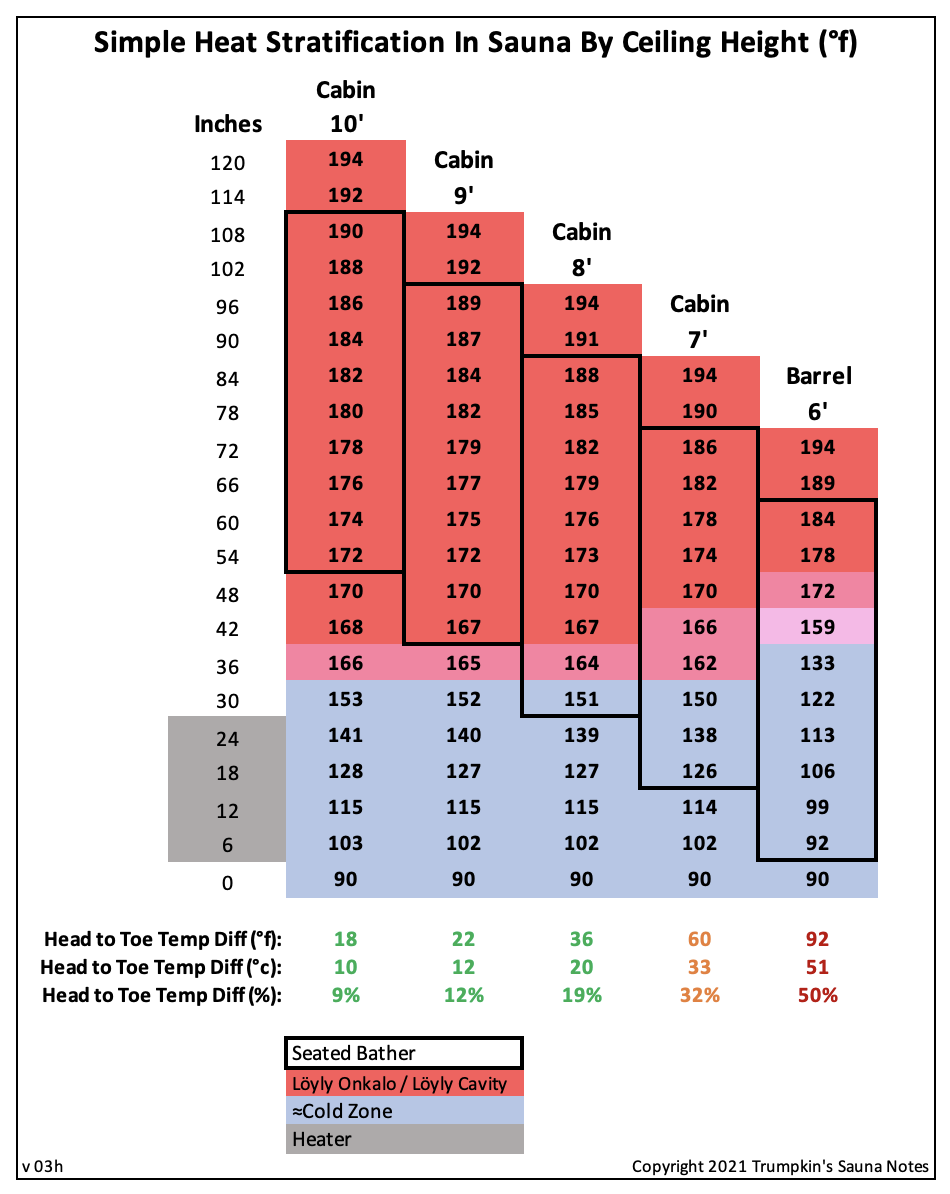
‘Cold Feet’ is the temp and steam relative to our head – feet should be no more than ≈15-20°c (27-36°f) cooler than our head and that’s impossible in most barrels. Actual measurements in barrels indicate feet anywhere from 61°f (best) to 122°f (worst) colder than head temps. Just head to sitting bench is about 62°f on average so even putting our feet up on the sitting bench still has too much stratification.
Interestingly, 200°f with fairly even head to toe and front to back temps is much more comfortable and enjoyable than 180°f with more uneven temps. This is why sauna builders in Finland work so hard to get benches up higher and why Finn’s never ask what the temp was but how the lóyly was.
Low benches also affect steam. When we throw water on the stones we want to feel the steam descend down on us from above and make its way down our entire body from our head to our toes enveloping us evenly on every inch. Bathers in barrels often only feel this down to their chest and maybe their waist. The steam in barrels often will not go below the widest part of the barrel.
Barrels can perhaps best be described as head saunas, not saunas.
Someone laying on the bench or sitting on it with their feet stretched out in front of them will not be as affected by this and this is what many barrel owners do. Not ideal but a somewhat OK workaround. There are a couple of steam problems with this though as not much of the steam goes down even to the sitting bench in a barrel and we can’t handle much steam anyway when we’re laying down. As well, keep in mind that pulling our knees up compresses our lungs and can limit free breathing.
No Heat Cavity Above The Door – A good sauna has a large cavity above the door to store heat. Without this a significant amount of heat escapes each time the door is opened which is uncomfortable for bathers, takes considerable time to reheat and is a waste of energy. This is worse in barrels as the shape effectively channels the heat up and out of the door. It’s like someone designed it to evacuate valuable heat as quickly and efficiently as possible.
And all that air leaving with the heat has to be replaced and it is – with outside air at whatever temp it is. That cold blast isn’t fun.
Direct Radiant Heat – Ideally in a sauna you don’t want any direct radiant heat, you want to be heated evenly all over by soft löyly. This is one reason for ‘Feet above the stones’. Bathers in a barrel experience significant direct radiant heat that leaves them hot on the side facing the heater and cooler on the side away from it (which is also the side that get’s blasted with cool air when the door opens). Glenn Aurbach describes it as like being a hot dog – you roast one side and then move over to the other bench to roast the other. That’s not sauna (more like an IR cabin).
No Vestibule – The lack of a vestibule is much more critical with barrels than with proper saunas since a door opening to outside cold air in a barrel results in much greater and faster heat loss. And similarly, since heat is escaping so much more quickly, cold air is entering down below much more quickly.
An additional problem that is much worse with barrels is build up of ice along the door threshold preventing the door from opening/closing.
Odors – Mostly due to mold and bacteria on the foot boards and benches but also because of poor ventilation and lack of air volume.
Poor Convective Loop – Some (or many?) barrels have a distorted convective loop. Among other problems this reduces or eliminates the evaporative cooling of bathers skin. This cooling makes being in the sauna more comfortable and more enjoyable.
Can’t Sit Up Straight – In some barrels it’s difficult or impossible to sit up straight for deep breathing or stretching our backs. Leaning back to relax is also not an option unless sitting sideways on the bench (which sometimes results in sitting kind of crooked which isn’t comfortable for our backs).
Leaks and Water Stains – Barrels are notorious for leaking and getting water stains on the inside. Rain or snow hitting a vertical wall such as an outdoor cabin sauna will run down it and stay on the outside, even with thin timber framing. Rain or snow hitting anywhere above the midpoint of a barrel will run down too, but with a barrel it’s running down to the inside through various cracks. Roofs sometimes help but not always as wind driven rain or snow can still cause problems. Some people find that keeping the door and a window open can help dry it out and others say that frequently heating it up, at least once per week, even when not being used, will help to keep it dry and the water stains at bay.
No Insulation – The lack of insulation not only results in greater energy loss and higher electrical costs but also to less bather comfort. The walls of barrels are sucking heat out much faster than saunas with proper insulation or thicker timbers which results in chilly backs for bathers. The few barrels I’ve seen in Scandinavia have been built from heavier 4-7” thick timbers which provide much better insulation.
Longevity – Barrels don’t last as long as cabin style construction. Rotted/dilapidated barrels that need to be hauled off by the junk folks are a not uncommon problem encountered by realtors in northern Minnesota. If well cared for and with a protective gazebo roof they can last 10-20 years or even more. Typically though they seem to provide about 2-4 years of use. This due to both the experience not being very enjoyable and to the general decline of the barrel itself.
The primary enemy is moisture which causes three longevity problems; warping, rot and mold. Warped staves result in gaps that can’t be closed by tightening the bands and so must be replaced. Rot results in general structural damage (and yes, cedar does indeed rot, despite marketing claims). All of these can result in an increasingly unpleasant environment, mold in particular.
Attempts at patching gaps often fail as the wood still wants to expand/contract and so new problems open up elsewhere – it’s like playing wack-a-mole.
Low Cost Is Misleading – Marketing materials say that the shape and smaller space to heat is an advantage, that barrels are more energy efficient. There are a few problems with that. First is the lack of a heat cavity and the shape that so efficiently channels heat out results in much more heat loss every time the door is opened. The lack of insulation combined with the shape and heat rising towards the uninsulated and leaky roof results in greater heat loss. And, since bathers are seated so low below the heat that’s higher up, a barrel must be heated to a higher temperature at the ceiling to maintain the same temperature at bathers heads as a cabin.
A rough calculation is that a barrel costs 2-5x as much to heat as a same footprint cabin. And this for a much worse sauna experience. A typical use includes about 4 hrs of heating time so that’s $4 for a cabin vs $8-20 per use for a barrel. At just twice per week that could be as much as $600-1,000 per year in increased operating costs.
Some or many barrels, because the wood stays wetter, may not have a very long lifespan and will need to be replaced or rebuilt sooner than a cabin.
There are also costs of add-ons. Many barrel owners find that they need to build roofs over their barrels to prevent leaking, insulate them, add a vestibule, build new higher benches, add better ventilation and other stuff to try to mitigate some of the problems inherent in barrels. And even with all of these additions it is still a much poorer experience than even a very small uninsulated cabin sauna.
Overall barrels just do not make good monetary sense. They are a bad investment.
Gullible Americans and Their Money Will Soon Be Parted – “A Barrel Is All I Can Afford” – A barrel is a bad investment. The proverbial throwing money down the drain. In many and perhaps most cases, after 3-5 years the value of the barrel is $0 – a barrel owner has nothing to show for their money. Or less if you have to pay someone to haul it off. Someone who says that a barrel is all they could afford is the person who is least in a financial position to buy one. In reality the only people who can afford to buy a barrel are the wealthy.
Financial Advisers say that in most cases of people being poor or low income it’s because of bad financial decisions. Buying a barrel is a bad financial decision. It’s a waste of money.
Disuse – A barrel experience is not that enjoyable except as a novelty or for hard core enthusiasts (and particularly those who force themselves to use it no matter how bad it is ‘because I paid for it’). Many people don’t use them often after the initial novelty wears off. As use declines so does the barrel since without frequent use people don’t notice the leaks when they begin and it’s not being heated and ventilated often enough to dry things out so rot, mold and bacteria begin to set in making use even less pleasant. By the time people realize they’ve stopped using it the barrel has usually declined too much to be of any value on the used market. And perhaps worse, people think that they’ve experienced sauna, when they haven’t.
This is in contrast to proper saunas that are used frequently without a decline in use.
More: 10 Things About Barrel Saunas and Why We Don’t Build Barrel Saunas.
If you already have a Barrel.
Saunum – A Saunum can help considerably with stratification and is the best and only solution I’m aware of to have a decent experience in a barrel. Talk to them about your specific requirements before buying though.
Add Better Ventilation – The typical passive vent-below-the-heater-and-exhaust-higher-up found in U.S. barrels is a recipe for bad air – it results in greater stratification, colder feet and does little or nothing to remove CO2 and pathogens.
Downdraft (Mechanical Downdraft in electric heated) will help to somewhat counter the extreme heat stratification and provide fresher air. Perhaps try four to eight 2-2.5” (15-30 face square inches) fresh air supply holes above the heater (aligned vertical or slightly staggered, beginning about 1/2 to 2/3 of the way from the top of the stones to the ceiling and evenly spaced). A wood updraft duct on the outside with the opening at about stone height that forces air to be pulled upwards will help to lessen any problems of reverse flow.
Then mechanical (powered) exhaust below the benches (or ideally below the floor/foot bench but only if also towards the back of the benches which is difficult/impossible in a barrel) on the opposite end. Figure about 20-25 CFM per person (so 80-100 CFM for a 4 person sauna). This should help to even the temps out a bit, lessen cold feet and will do a better job of removing CO2 so bathers will have fresher air to breath.
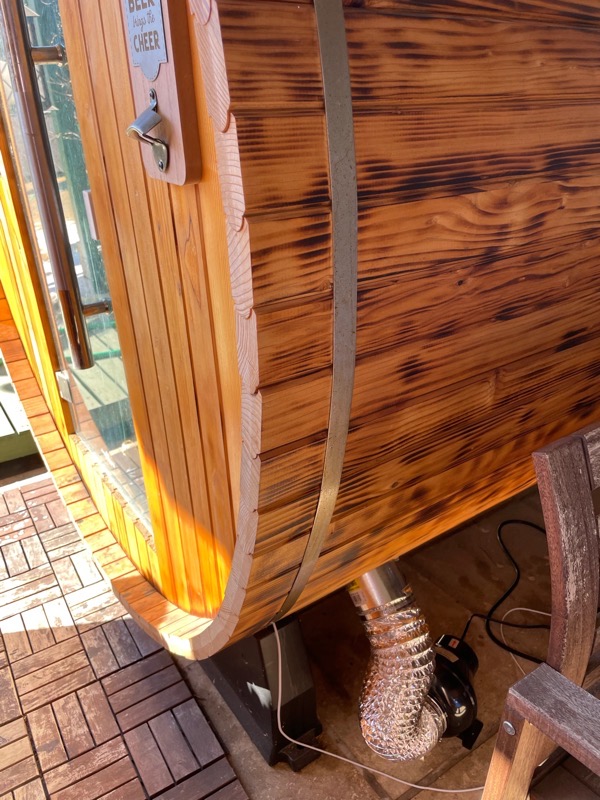 Hakka-Sauna’s mechanical exhaust
Hakka-Sauna’s mechanical exhaust
If in North America you may still need some minimal amount of air flowing in behind/below the heater to cool the UL mandated high-temp sensor. This vent should be adjustable so that it supplies only the minimal amount needed to cool the sensor so that the rest of the supply air enters above the heater where it can benefit bathers.
More: Sauna Ventilation and Improving a Barrel Sauna – A Case Study.
Mechanical Supply – Typically for mechanical downdraft you do not want a mechanical supply, only mechanical exhaust. In barrels however, due to the high leakage, it may be necessary to also do mechanical supply. Mechanical supply can result in too high of air flow velocity which will reduce mixing. Exhaust side only results in supply air being pulled in (rather than pushed in) which results in better and more even mixing. Forced supply can also result in the barrel becoming slightly pressurized which you do not want in a sauna with insulation. However, in a barrel without insulation and with air leaks between the staves you may want the interior slightly pressurized to prevent cold air entering through the leaks. In this case doing both supply and exhaust may be warranted. Hakka-Sauna followed these recommendations and achieved moderately good results
Raise the benches – As much as possible and then raise the floor (that’s acting as a foot bench) to 14-16” below the benches. Moving the benches in towards the center a bit may allow a bit more head height for raising them. Normally you’d want the foot bench above the stones and sitting benches 16-18” above that but here that will be difficult or impossible so as high as practicable for each is the best we can do. Making some 4” – 6″ foot stools for people to use might help as well. Be careful about floor to heater clearances though.
Create A Heat Cavity – A ‘löyly curtain’ or bit of wood across the top of the door opening that shortens the opening and creates a bit of a heat cavity above the door opening may help to preserve heat when the door opens. And since heat isn’t escaping as fast out of the top, then hopefully less cold air will come in near bathers feet. This might be particularly useful if people are coming and going at different times. Careful for people hitting their heads though.
Add A Vestibule – A vestibule of some sort to act as an air lock would prove quite beneficial. At some point though it’s just best to jump straight to building a proper sauna.
Add a Roof – Barrels are notorious for leaking and rotting. A roof over it will help with both. Make sure there is plenty of airflow between the barrel and roof to prevent mold and rotting.
Keep It Dry – The enemy of barrels (and all structures) is moisture. Protect it from rain & snow. Make sure ALL surfaces can air dry. Even if not using it, heat it up occasionally to dry it out.
Barrels do lead to some great ingenuity trying to correct the problems!
Many people add roofs to try to lessen the leaks that happen during rain and snow.
This first one is my favorite. Very nice looking gazebo to protect their barrel. And an 8’ barrel so much better than smaller. If, instead of buying the barrel, they’d enclosed that nice gazebo they’d have a much better sauna with more interior room and higher benches. It’d be much more comfortable, less stuffy and more even heat head to toe. But alas, they didn’t know they’d need the gazebo when they bought their barrel.
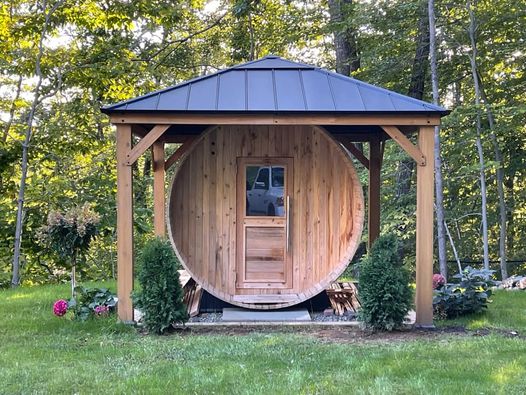
This one’s nice too. Though I’m not sure how it will hold together and keep from splaying.
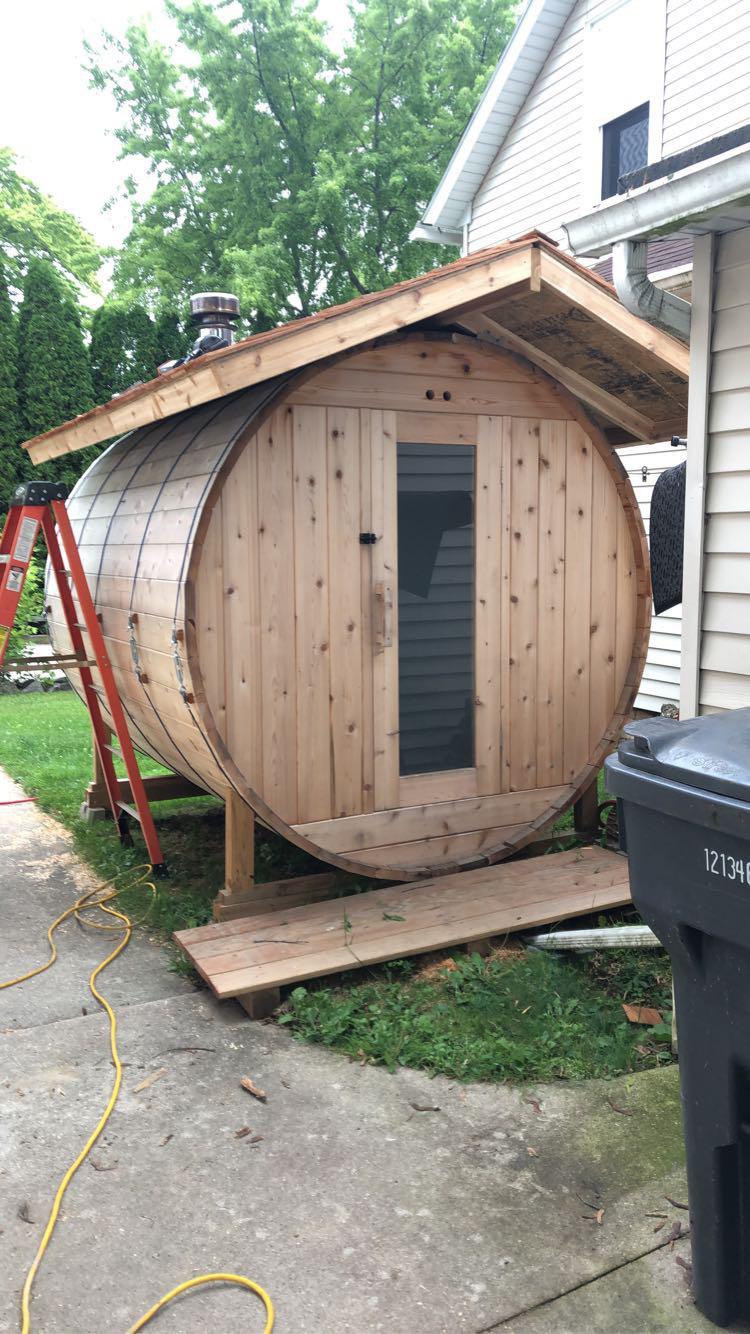
A couple of sitting boxes on top of the bench along with a couple of different foot boards to try out. Good thing this is a larger diameter.
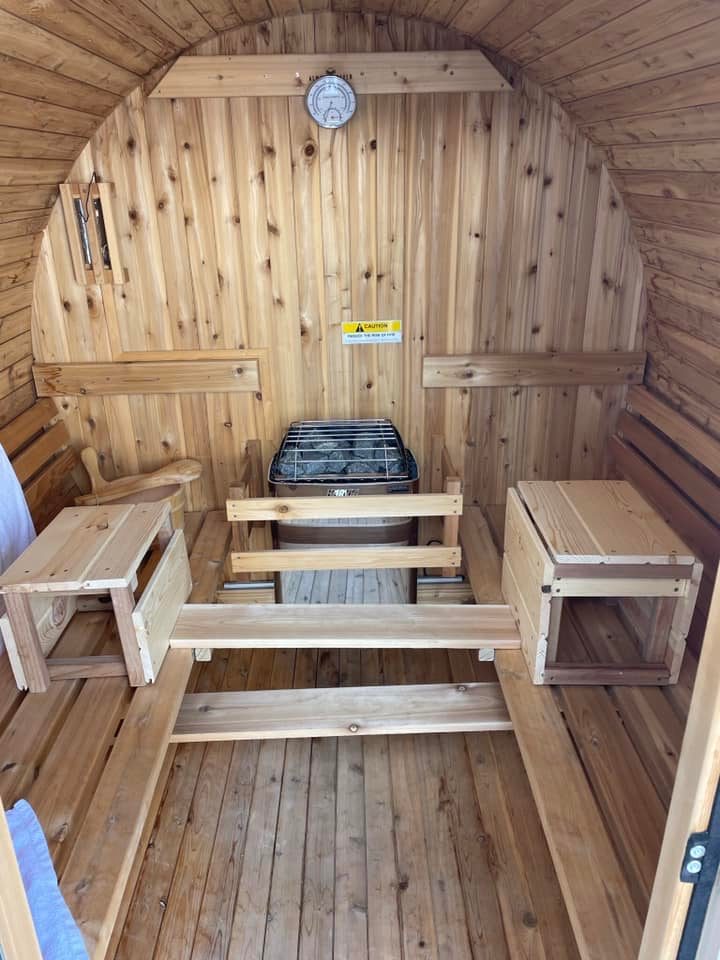
Box Chair on top of the bench!
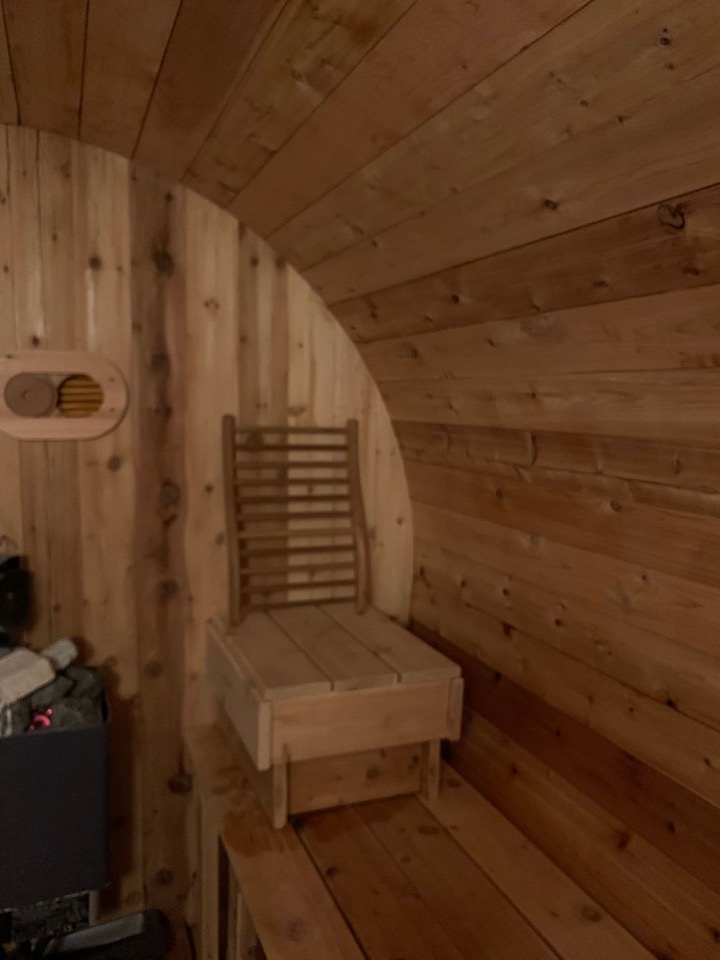
Stools on top of the bench.
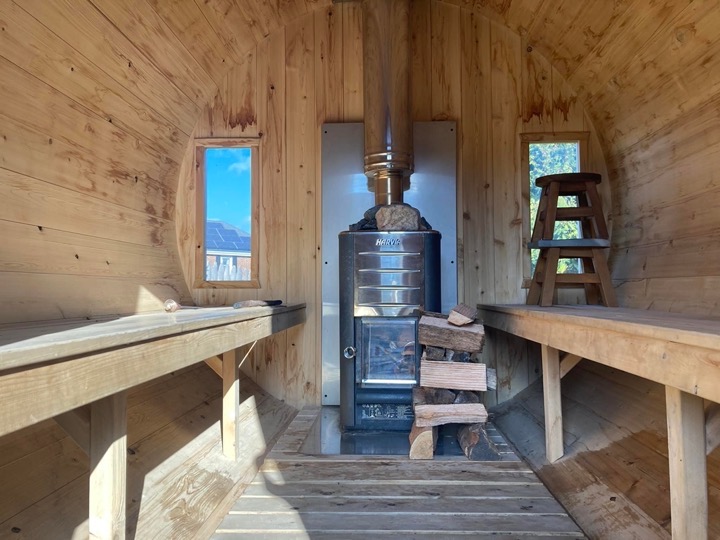
A twofer: Boxes on top of the bench and they recessed the heater out of the back.
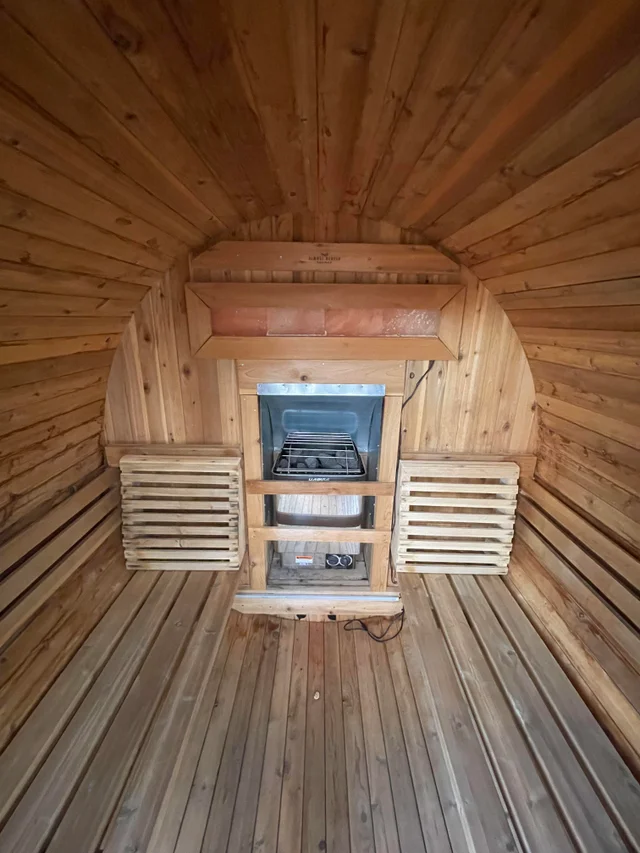
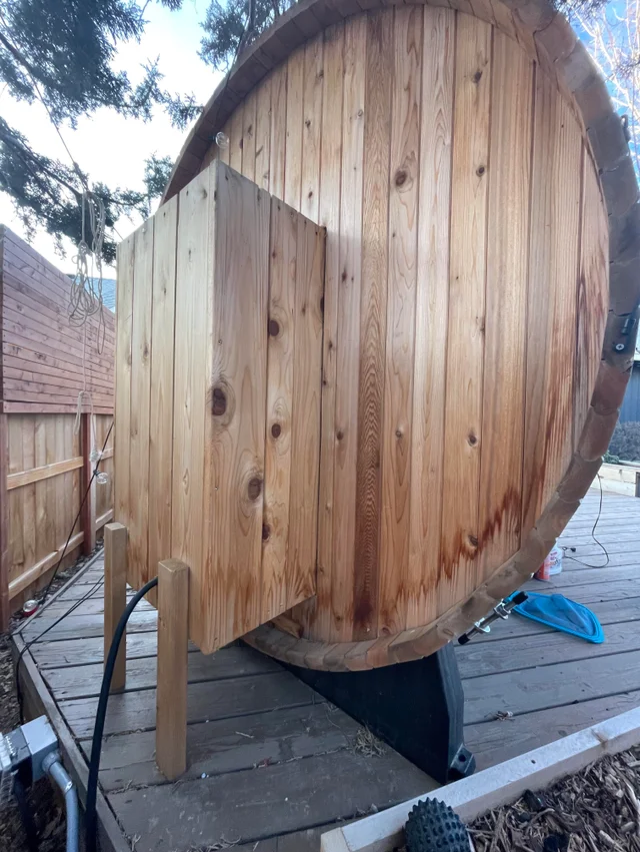
For this box on the bench they’ve added legs so that it can be moved towards the center for more headroom: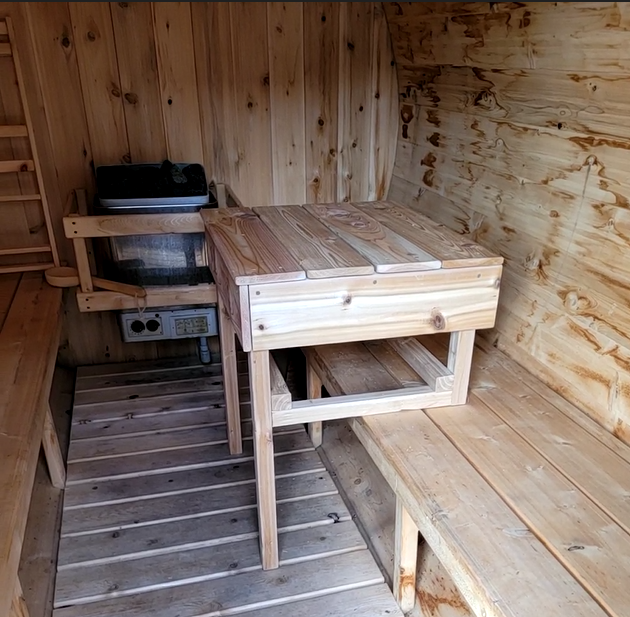
So that they can get even higher with a chair on top: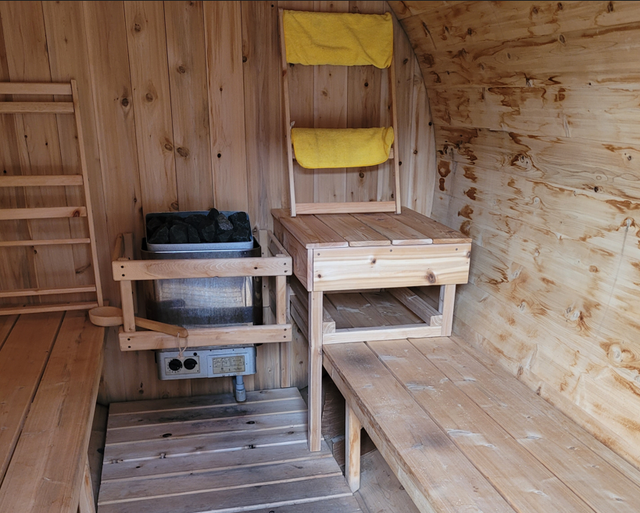
And another!
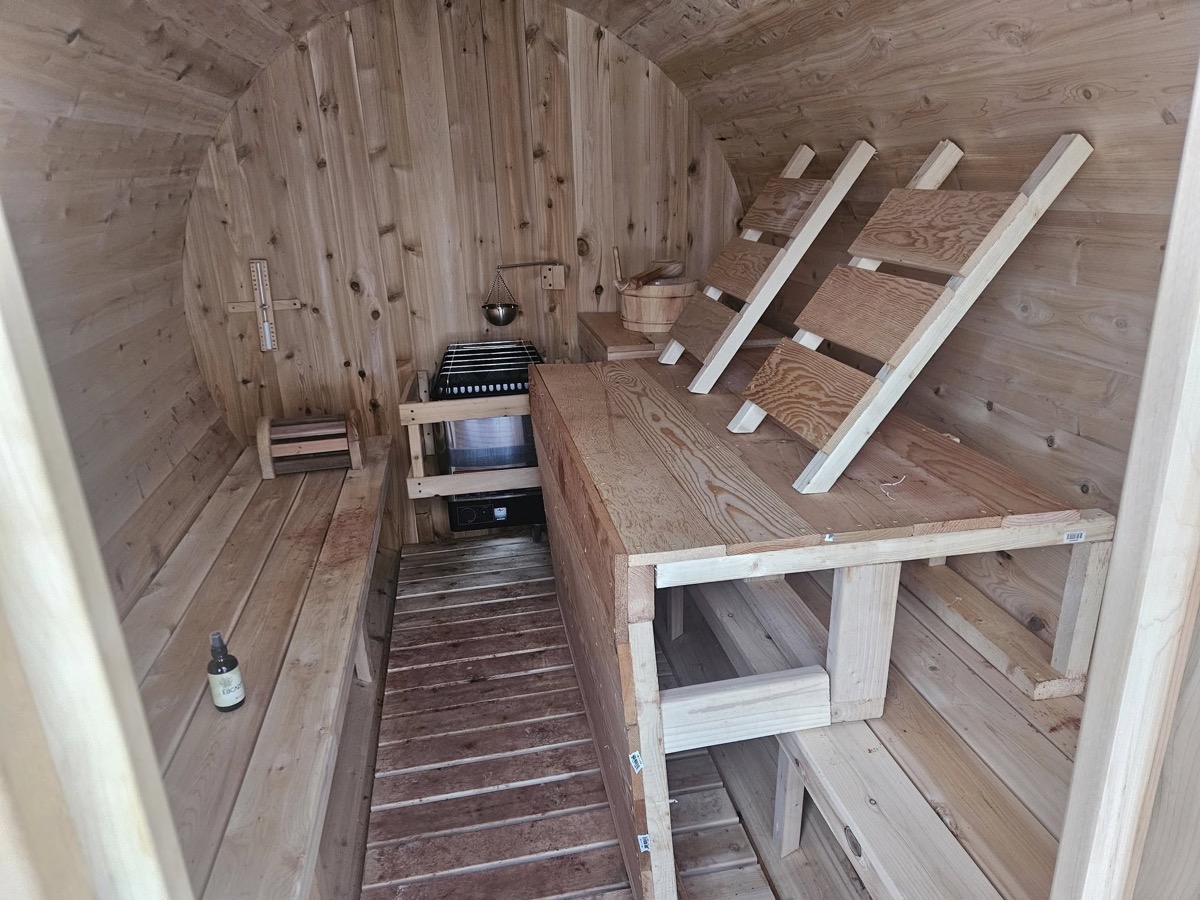
A vestibule complete with romantic lighting.
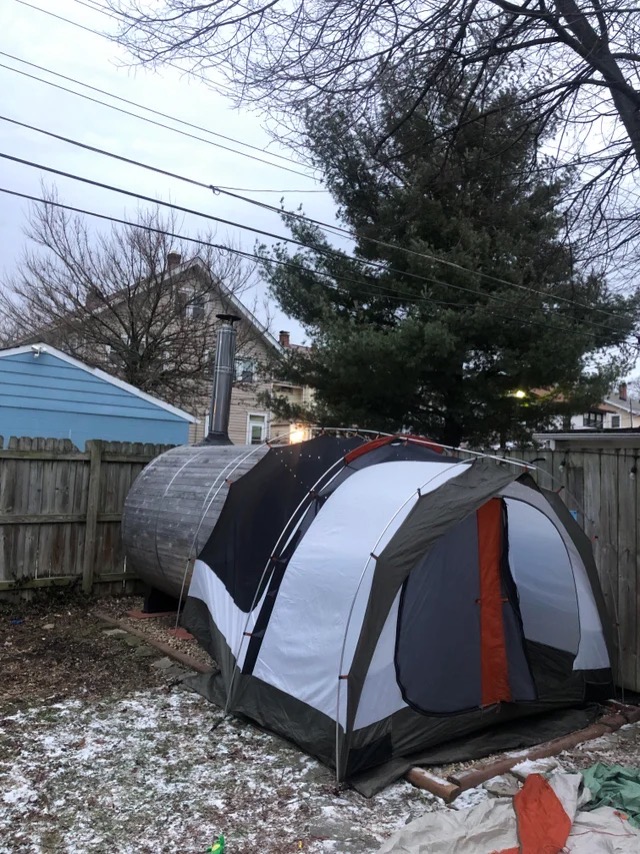
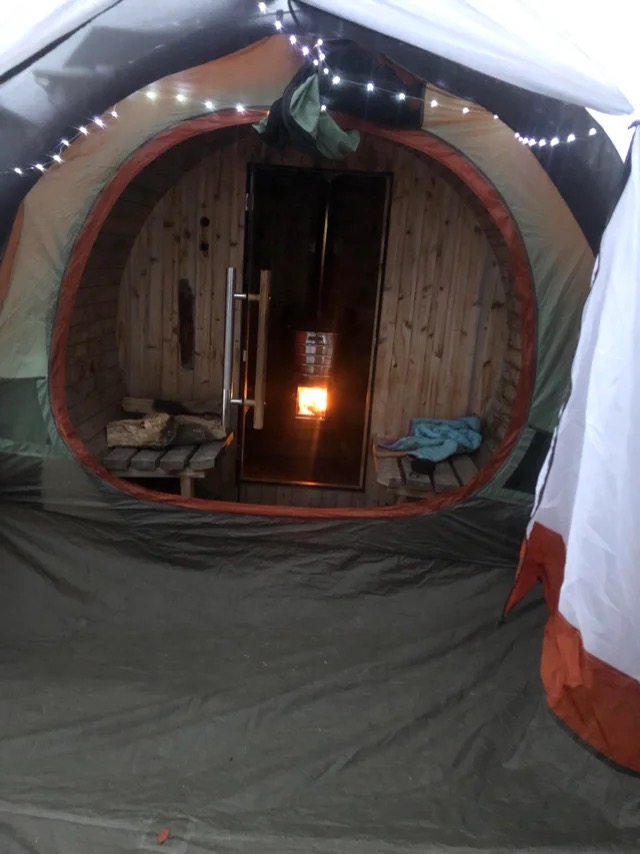
A Better Barrel?
A cube shaped barrel can alleviate some of the problems of round barrels if designed well. They will still have problems of no insulation, cold feet and chilly backs as well as a potentially shorter lifespan. The round shape of barrels is critical to the structural integrity so there have been problems of these not-so-round barrels having more problems with loose stays than round barrels.
Both of these are lacking a heat cavity but a larger cube could fix that.
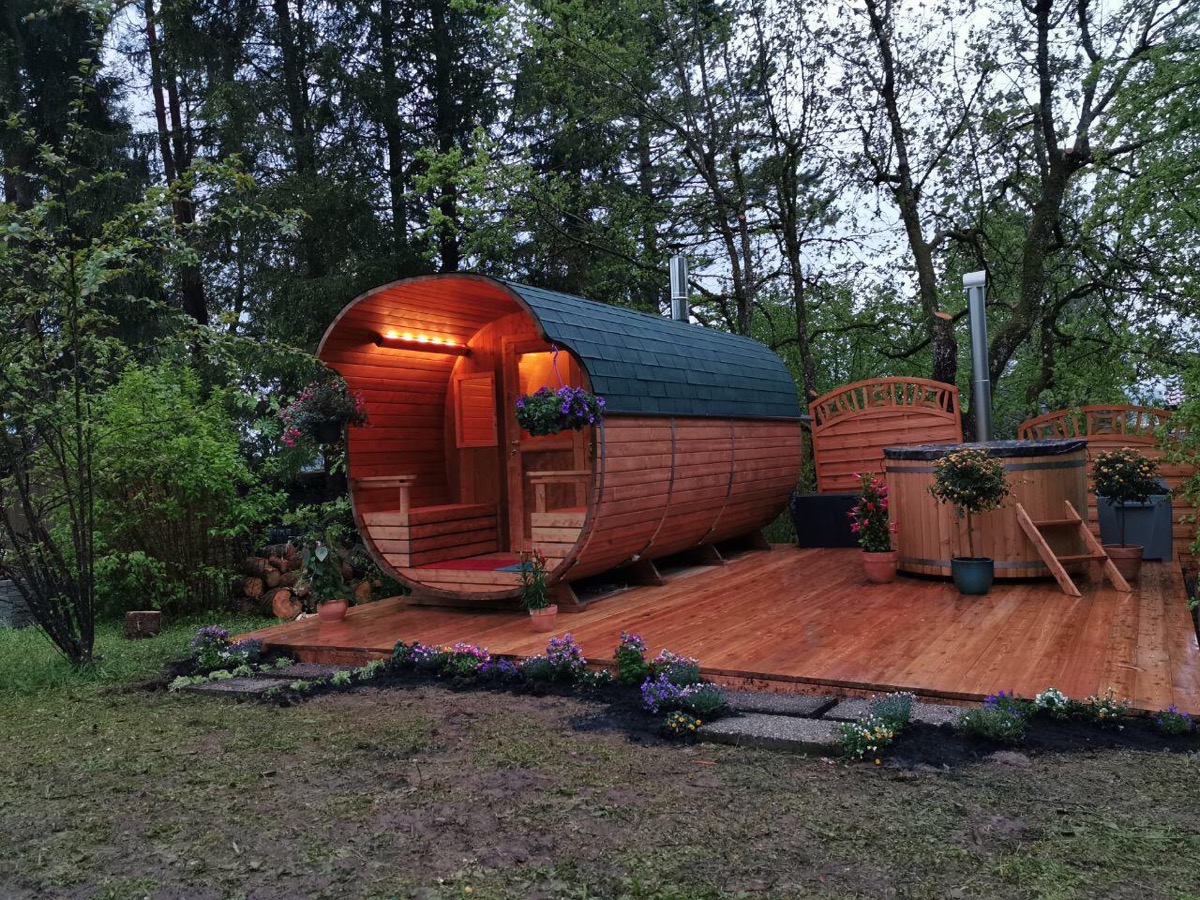
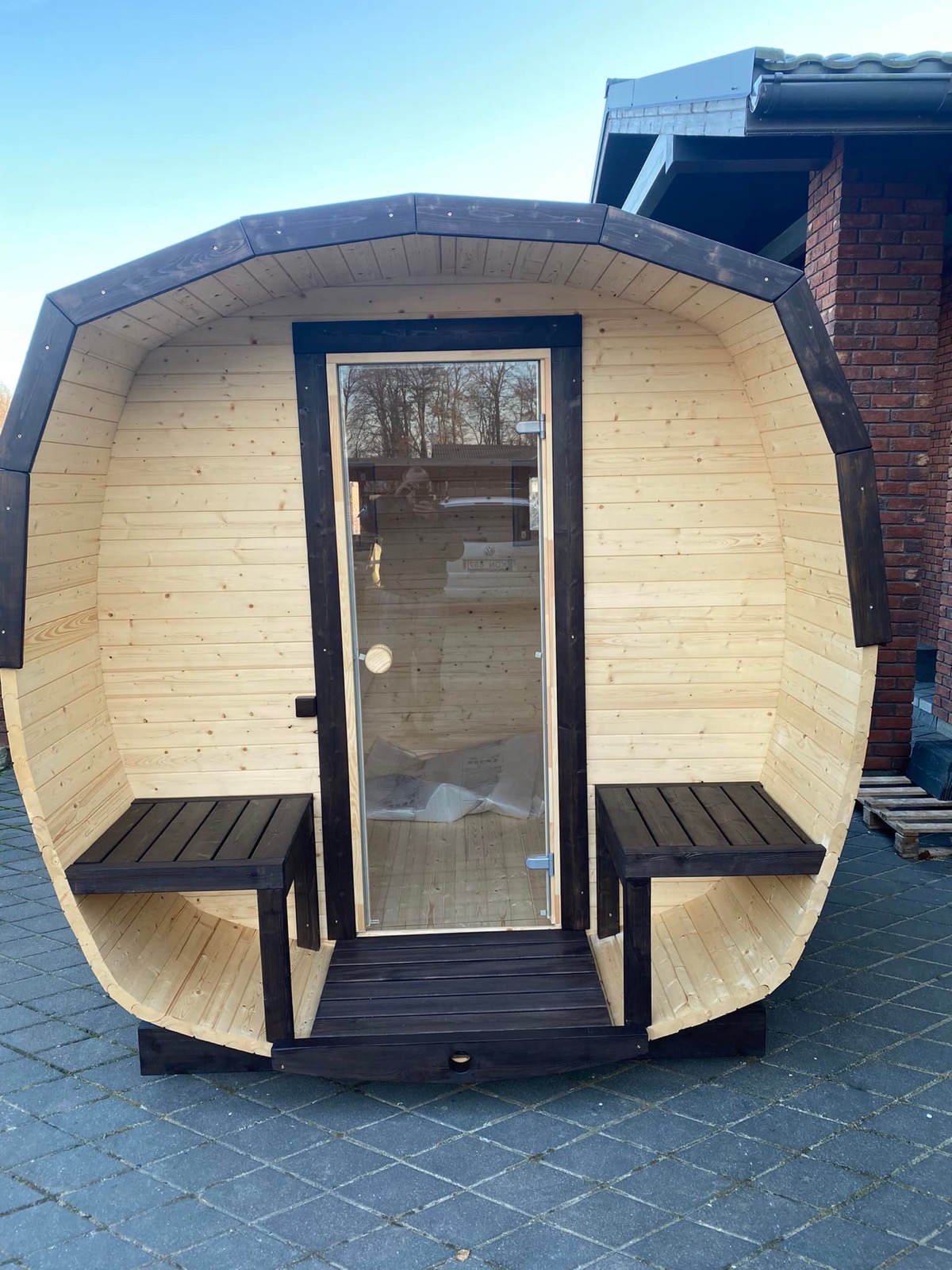
Igloos
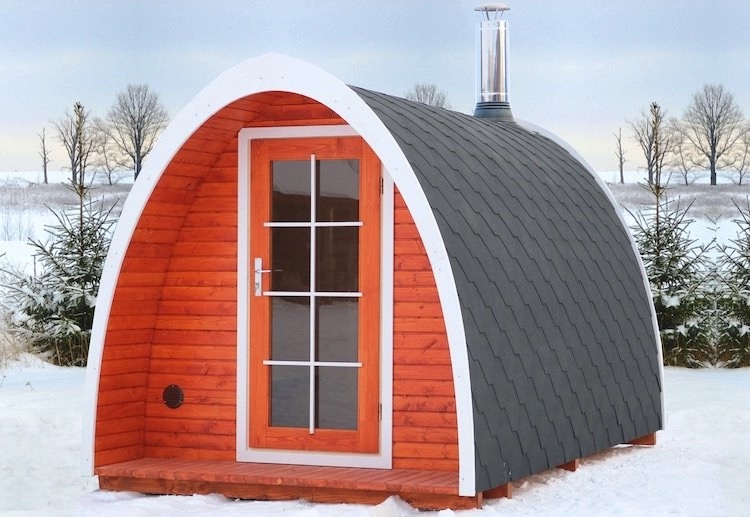
This design has similar problems as a barrel and should be avoided.
More to come…
——
* Pathogens, including viruses such as Flu and Covid-19, often spread via droplets in exhaled breath or sneezing. Covid-19 is believed to be able to survive at 75°c for up to 3 minutes, at 65° for up to 5 minutes and 60°c for up to 20 minutes. The survival rate at higher temps is unknown. It is possible that Covid-19 would be killed quickly at higher temps and perhaps quick enough that numerous people in a sauna that is perhaps 95°c at bathers shoulders would have little risk of transmitting it. More: https://www.ncbi.nlm.nih.gov/pmc/articles/PMC7372531/, https://www.ncbi.nlm.nih.gov/pmc/articles/PMC7372531/
